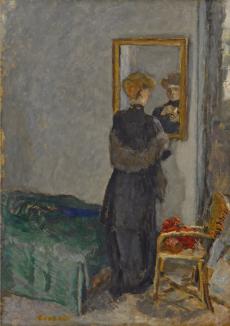


In 1891 the commission for an advertising poster placed by a champagne company with the young Pierre Bonnard convinced his father once and for all to allow him to pursue his vocation as an artist. The young man, who was then 24 years old, was studying law and, at the same time, had been attending, since 1887, courses at a private Parisian art school, the Académie Julian, where he became friends with a group of young artists. Among them was, first of all, Paul Sérusier (1864-1927), who, in the autumn of 1888, had surprised his friends with a small, vividly coloured panel, a landscape painted at Pont-Aven ‘under the direction of Paul Gauguin’: this work became Le Talisman (Paris, Musée d’Orsay) for himself and his friends Maurice Denis (1870-1943), Paul Ranson (1864-1909), Henri-Gabriel Ibels (1867-1936), K.-X. Roussel (1867-1944), Édouard Vuillard (1868-1940), René Piot (1869-1934) and, of course, Bonnard. These young people, who were learning less from the tradition taught by their teachers, than from the experience of Paul Gauguin (1848-1903), Vincent van Gogh (1853-1890) and the Impressionists, called themselves the ‘Nabis’, that is to say, the ‘prophets’ – or the ‘initiated’ in Hebrew. This small Symbolist and esoteric avantgarde clearly followed in the wake of the master of Pont-Aven. Bonnard became the ‘Japanese Nabi’, the adjective underscoring his particular fondness for forms painted in solid, contrasting colours, as well as for the dynamic graphic style of Japanese prints, which the West had discovered and admired since the mid-19th century. Even though painting remained his principle means of expression, he also accorded much attention to print-making, especially lithography, which at the time, due to such masters as Jules Chéret (1836-1932) and Henri de Toulouse-Lautrec (1864-1901), was experiencing a remarkable blossoming. After the France-Champagne poster, which captivated Toulouse-Lautrec, Bonnard achieved his first artistic successes with his posters and illustrations. By creating, in 1894, the poster for La revue blanche, Bonnard found himself in the bosom of the most innovative literary and intellectual milieux of his time (he later became an illustrator for Paul Verlaine, Alfred Jarry and Octave Mirbeau) and formed a particularly close bond with one of the founders of this journal, Thadée Natanson, whose wife, Misia, muse of numerous artists, would also become one of Bonnard’s favourite models. Through his schoolmate Aurélien Lugné- Poë, Bonnard maintained equally close ties to the avant-garde theatre circles of Paris.
Parisian life, the insignificant events of everyday routine and the intimacy of family, which Bonnard viewed with indulgent humour, provided him with his first subjects, as had been the case with the Impressionists. The summer, by contrast, brought him back to painting landscapes, depending on where he went on holiday. He was also interested in the nude, and his future wife, Marthe, posed for him. The fancifulness of his compositions, their unusual formatting, the views from above (surreptitiously captured or arbitrarily cropped), points of view that cannot but evoke his talent as a photographer – all these were quickly noticed and appreciated, as was his confident instinct as a colourist.
Having exhibited his work regularly at the Salon des Indépendants since 1891, Bonnard also participated in the first Salon d’Automne in 1903. His first solo show took place in 1896 at the gallery of the art dealer and Impressionist advocate Paul Durand-Ruel. After an initial negative reaction, the Impressionists Camille Pissarro (1830-1903), Pierre-Auguste Renoir (1841-1919) and Claude Monet (1840-1926) allowed themselves to be seduced by Bonnard’s subtle art. Like his Nabis comrades, Bonnard also showed his work at Le Barc de Boutteville, and with Ambroise Vollard (who was also his publisher) and then Bernheim- Jeune, his dealer until the end of his career.
After 1900, as the painter evolved, he seemed to abandon somewhat the style of decorative rhythms and bold colours of his beginnings. Around 1905, he tackled a series of small-format compositions, dedicated to the representation of female figures in domestic interiors. These consist mostly of undressed models posing in his studio or putting their clothes back on, or women who are reading or sewing – intimate scenes, suspended moments of ordinary actions. His subjects are reminiscent of Degas and are similar to those painted by his friend Vuillard. It is in this context that we should view the painting in the A. G. Leventis Collection. The model, neither Marthe nor Misia, is not identifiable. In his restrained palette of greys and greens, scarcely warmed up by tones of ochre or orange, one does indeed rediscover that ‘grey painter [who] likes purplish, russet, and dark nuances’ so admired by the critic Gustave Geffroy, a friend of Monet and Paul Cézanne (1839-1906), ever since Bonnard’s first solo exhibition.
Yet, as early as 1908-1910, Bonnard returned to using intense coloured accents, which he explored until the end of his career and which is the most common hallmark of his art. This development no doubt owes much to his discovery of the Midi region of southern France, where he often stayed. In fact, he ended up acquiring a house in Le Cannet, where he passed away in 1947. Opposite Henri Matisse (1869-1954) on the one hand, and Pablo Picasso (1881-1973) and Georges Braque (1882- 1963) on the other, Bonnard is revealed to be one of the greatest painters of the 20th century.
He studies law at the time as training as an artist at the Académie Julian in Paris. His first success came with printmaking, designing posters and illustrations. He was a leading member of the Nabis group and was influenced by Art Nouveau and japanisme. Along with his friend Édouard Vuillard, he developed Intimism, the depiction of intimate domestic interiors, executed in a flat, linear, playful style, usually using bold colours. He also painted several self-portraits, landscapes, street scenes and many still lifes. He took up photography in the 1890s.